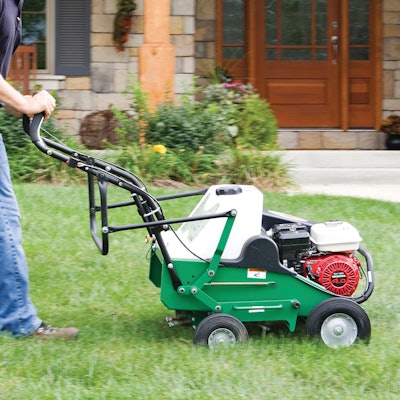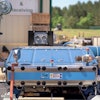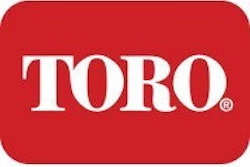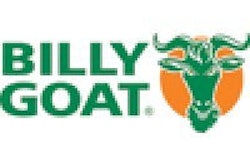
Last summer was brutal on turf in much of the country. Record high temperatures coupled with little rain did serious damage to grass, leaving behind brown patches of denuded earth. Now that spring has sprung, your customers will look to you for help in restoring the beauty of their outdoor landscapes. Are you ready?
To effectively serve landscape professionals and homeowners interested in repairing distressed turf, you must start with having the right equipment in your fleet.
Get rid of the dead stuff
The first step in bringing new life back to damaged turf is to remove excess thatch, so first steer your customers toward a dethatcher, or power rake. "Remove as much of the dead plants as possible," says Bob Brophy, director of lawn products at Turfco Mfg. Inc. "Take two passes with a dethatcher and rake or use a good bagging mower to remove the dead plants."
Dethatching becomes a priority when thatch buildup from the prior season exceeds a quarter inch or more, says Pierre Pereira, vice president of sales and marketing at Billy Goat. "Excess thatch can prevent water and nutrients from reaching the soil and contribute to fungus and turf disease."
Give it some fresh air
Next, your customers will need to aerate their lawn with a coring aerator. Aerators work by relieving soil compaction in the top few inches of the soil and improving root depth as well as air, water, fertilizer and nutrient flow. "This increases turf health, drought resistance, and results in less stress, fewer weeds and pest problems," Pereira says.
Once the aerator loosens and fractures the soil, the hole will make an excellent growing medium for tender new plants, forcing roots to go deeper for water and nutrients, making them stronger and more resilient in the long run. "A big mistake most people make with new lawns is they water too frequently and the plants keep their roots on the surface, where the water is." Brophy explains.
Instead, instruct customers to water deep to drive the roots down. "Keep in mind that grass plants are basically lazy," Brophy says. "If you give them the food and water on top of the soil, they will not put down roots then when the water and food are gone... then the plants die."
Anna Foster at Toro says aerating should be done in the spring or the fall when temperatures are cooler and grass is growing and benefits most from better access to water and nutrients. "Aerate when soil is moist, but not too wet, to allow full cores to be pulled out by the aerator," she says. "In drier conditions, soil may need to be watered one to two days before aerating."
Plant for new growth
Finally, it's time to overseed with a high-quality seed specific to the growing zone. If your customers aren't sure about what seeds to use, suggest they check with a local agriculture extension agent, turf professional or seed supplier to determine the best plants/seed.
"After a lawn is aerated is a great time to use an overseeder," Foster says. "An overseeder cuts slits into the soil and disperses grass seed with one machine. Coupled with aerating, seeding will help the grass seed penetrate the oxygen-rich soil for maximum growing conditions."
Brophy says the overseeder should be of high quality, using fixed knives or verticutting blades. "These are blades that are rigid and sharp and cut through the thatch and into the soil. The machine must be capable of making a cut at least 3/8 of an inch into the soil for seed placement," he says. "This is critical, since seed placed on top of the soil and thatch is really just bird food. Seed needs to have soil contact to survive and grow. Verticutting machines do that."
According to Brophy, spacing of the cuts or slits into the soil should be no wider than 2 inches, and less is better. "The closer the cuts, the more of them in the lawn," he says. "The operator should make two passes over the lawn with the overseeding machine to make sure he gets the proper amount of seed evenly over the lawn. Make one pass and measure the remaining seed. If more than 50 percent of the seed is used, go lighter on the second pass. If less than 50 percent of the seed is used, go heavier on the second pass."
Pereira advises, "Cut your lawn short before overseeding, then lay down seed at half the rate, but go over it twice in a 45-degree criss-cross diagonal pattern."
Correct timing and sequence for seeding will depend on the climatic zone, seed and weather. Best seeding is done in the fall. Spring seeding involves battling weeds, so suggest that customers use a fertilizer with weed control.
"Consider the impact of spring weed control or fertilizer on young grass shoots," Pereira warns. "Consult your nursery first."
Selecting equipment
When choosing turf renovation equipment for your inventory, choose a supplier that can supply parts overnight. "Broken equipment makes no money. You need someone you can call for service and advice when you need it, not just a number to call and leave a message," Brophy says. "You need a supplier that stands behind its equipment, provides quality, tough machines and will warranty the machines for the rental industry and use."
When selecting a dethatcher, look for infinite height adjustment to improve blade life along with strong tires, greasable bearings, and a fold-and-go handle with inside bail and cross bar for simple transport.
For aerators, look for simple tine engagement and disengagement, along with low-fatigue turning and simple ramp loading. "Also important is O-ring chain and greasable bearings for improved uptime," Pereira says.
"For overseeders, hydrostatic drives completely take the fatigue factor out of traditional models and make overseeding simple for customers, he says. "A floating cutting head is also key to help maintain blade to soil contact for better germination."
Evaluate your customer base and select a fleet of products that helps you meet the different needs of professional contractors and homeowners. "Homeowners are focused on one yard at a time and want easy-to-transport and easy-to-operate equipment, making smaller, mechanically driven aerators, seeders, and dethatchers perfect for this market," says Foster. "Products for homeowners will be lightweight, have folding handles for easy transport, and will have about 18 inches of operating width."
Professional contractors, on the other hand, want larger, higher-powered units that offer more productivity and provide a better rental value. "Hydraulically driven equipment with operating widths from 21 to 30 inches allow professional contractors to cover more ground, and platforms on larger units to minimize operator fatigue. To maximize your rental opportunities and serve more customers, build a fleet that meets the needs of both homeowners and professionals."
For the most successful rentals
One of the most important things you can do to ensure a productive and profitable rental of turf renovation equipment is to ensure your customers are clear on how to use it, particularly if they're homeowners.
"Make sure your customers are comfortable operating the equipment before they leave the store and provide a copy of the operator’s manual or direct them to the manufacturer’s website to see operator safety videos and download operator guides," says Foster.
Brophy agrees. "Use the manufacturer's operating guides and videos... always."




















